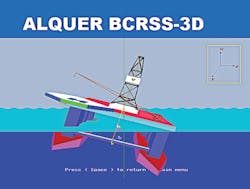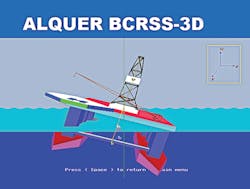Ballast control and rig stability simulator designed to provide eTraining
Rio de Janeiro-based ALQUER has introduced the ALQUER BCRSS-3D Ballast Control & Rig Stability Simulator, designed to provide eTraining. The simulator is a full computer-based system that has been designed to provide students with practical “hands on” training for the measurable results within the shortest time period, also considering mobility.
The simulation scenarios are designed to faithfully reproduce the appearance and functions, on a PC screen, that can be found on the control panels of a semisubmersible rig. A digital mooring control panel will allow student operation of the anchor winch motors. Dynamic, real-time coordination of all internal and external forces effecting the rig, will give the correct responses in all directions – heel, trim, roll, pitch, heave, surge, sway, yaw, rotation – along with a constant update of the rig stability data analysis screen, as draft, displacement, KM, GM, GZ, BM, FS, Center of Gravity, and Center of Buoyancy. Internal forces considered include not only the ballast and consumable systems, but also the deck load and the mooring systems and changes in these systems that are both immediate, i.e., in real-time and occur every second. This includes movements of the rig of location due to changing anchor tensions that result from operation of the winches or environment forces. Damage effects due to added weight or lost buoyancy can be observed.
The ALQUER BCRSS-3D Ballast Control & Rig Stability Simulator has been designed to provide students with practical “hands on” training.
In addition to internal factors, wind and wave current forces act upon the rig simultaneously giving real-time responses. The simulation can also control sea water density at any level for salt water, fresh water, or aerated due to subsea blowouts
Concurrent with any stability problems created by the factors mentioned above, the instructor has control over the mechanical integrity of the system itself. Failures at any point, single or multiple, immediate or sequential, will be realistic and demand the same process of detection and correction required for the on-board BCOs (Ballast Control Operators) personnel.
The objective of providing practical realistic training will be met. New personnel orientation, illustration of stability principles, rehearsal of normal, abnormal and critical operations and emergency preparedness will be greatly enhanced.
Through instructor’s workstation, there is access to the entire system at all times and status can be reviewed or set-up activities as desired. Using 80 plus color graphics digital screens, instructors and students will have field for observation of current system operating status. Instructors can save and replay exercise parameters on the computer hard drives. This saves the instructor the time of reintroducing his training exercise data with each new student group. Any saved exercise can be interrupted at any time to introduce different faults or failures.
Training instructors can develop specific exercises that can be saved for future learning scenarios. This enables students to analyze and review specifics and evaluate emergency procedures as needed.
By concentrating on the key areas of realism, the students training effectiveness, instructor flexibility, based on a digital platform, the design for the Alquer Ballast Control & Rig Stability Simulation with the 3D computer graphic screen allows practical, economical and productive training results, even aboard MODU semis, and in the near future remotely. •

